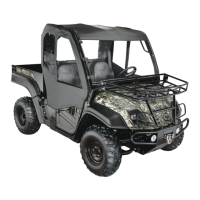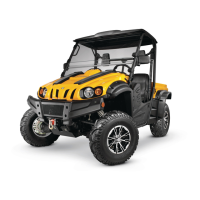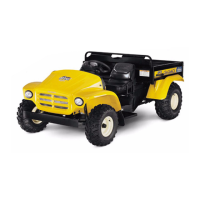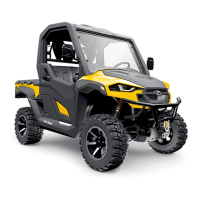11
WARNING: Do not stop or start suddenly
when going uphill or downhill. Be especially
cautious when changing direction on slopes.
Apply brakes when going down slopes to
maintain control of vehicle.
• Release brake pedal and apply pressure to the
accelerator pedal.
• Release accelerator and apply brake pedal evenly
and firmly to slow down or stop.
Operating The Headlights
To turn the utility vehicle’s headlights on:
• Start the engine following the instructions earlier in
this section.
• Turn the key one notch counterclockwise into the
On/Lights position of the ignition switch. Refer to
Figure 4.
To turn the utility vehicle’s headlights off:
• Turn the key either into the On position (to leave the
engine running) or the Stop position (to shut the
engine off). Refer to Figure 4.
NOTE: Never move the key into the Start position while
the engine is running. Doing so may cause damage to
your engine’s electric starter.
Engaging Differential Lock
• Stop or slow vehicle speed and pull up on lever to
lock differential. The differential will remain
engaged as long as lever is held in the up position.
IMPORTANT:
Engage the differential when the left and
right side wheels are turning at slightly different speeds.
Do not attempt to turn when differential lock is engaged.
WARNING: To avoid transaxle damage or
injury, go slow when operating vehicle with
differential lock engaged as steering
response is noticeably reduced.
Disengaging Differential Lock
• To disengage the differential lock, simply release
the lever, allowing it to return to the bottom position.
NOTE: Torque must be equal on both axles for
differential lock to release. It is best to slow down and
drive straight ahead at a constant speed when
disengaging the differential.
Raising and Lowering Cargo Box
WARNING: To prevent the possibility of
bodily injury from unintentional lowering of
the cargo box, be sure vehicle is on a level
and stable surface and parking brake is
locked before raising cargo box.
• Park the vehicle safely and turn key to the RUN
position.
• Raise cargo box by pressing and holding top of
electric lift switch. Release switch when box is at
desired dump height or when maximum height is
reached.
NOTE: A ratcheting noise will indicate cargo box is at
full extension. The same noise will also be heard when
cargo box is at the full down position. If lift capacity of
the power lift is exceeded, a ratcheting will also be
heard.
• To lower cargo box, push on bottom of electric lift
switch. Turn ignition switch to the STOP position.
Figure 12
Dumping Load From Cargo Box
• Back up the vehicle to the dump site and apply
parking brake.
• Unhook the tailgate from cargo box.
• Using the electric lift, raise cargo box to dump load
and lower box when empty.
WARNING: The center of gravity changes as
a loaded cargo box is raised. Do not allow
rear wheel to hang over the edge of a loading
dock or ravine. The cargo box weight may
shift over center and vehicle could tip over
backwards.
WARNING: A loaded cargo box can be very
heavy. Do not attempt to dump a loaded
cargo box unless vehicle is equipped with an
electric lift option.
IMPORTANT:
When dumping with the electric lift, stop
immediately if actuator clutch slippage occurs. Lower
cargo box completely and remove excess load by hand
before dumping.
• Reconnect the tailgate to the cargo box. Do not
drive the vehicle with cargo box in the raised
position.
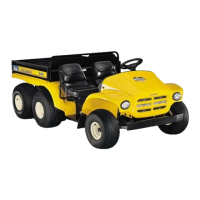
